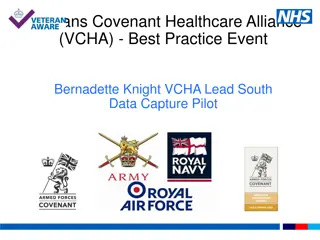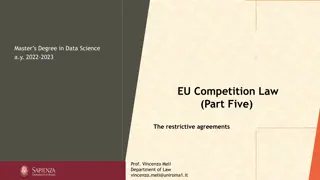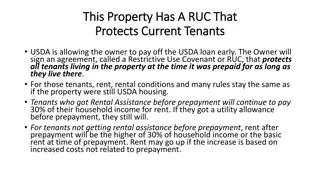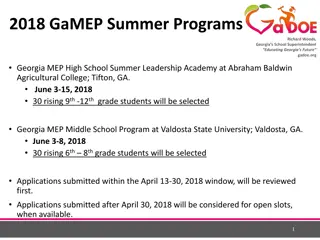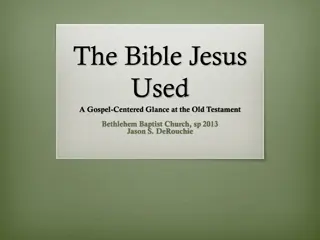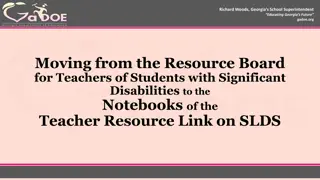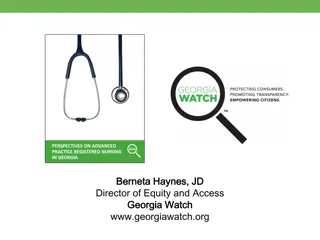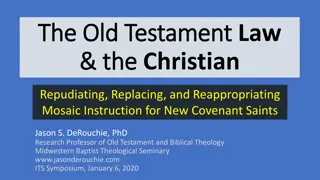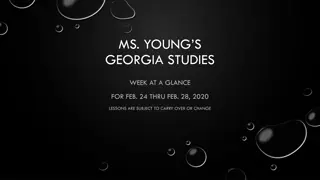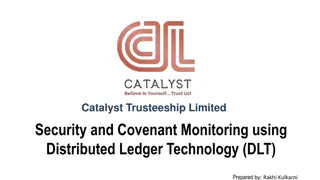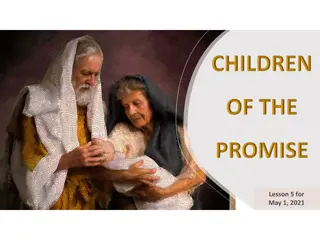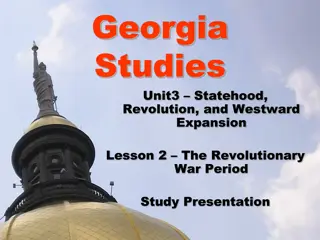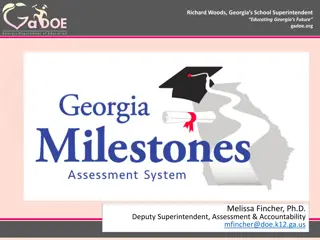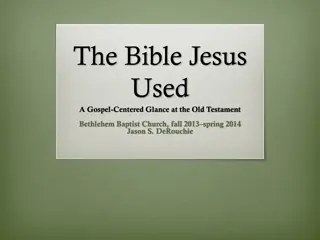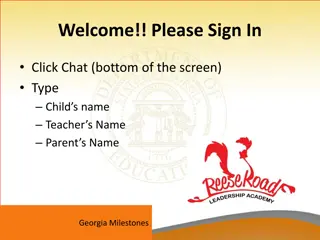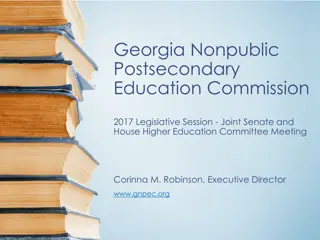New Georgia Restrictive Covenant Law Analysis
This content delves into the details of Georgia's new restrictive covenant law, its effective dates, associated Constitutional challenges, and observations on its impact. It covers the journey of legislative changes and amendments leading to the current law, offering insights into the legal landscape around non-competes and trade secrets.
Download Presentation

Please find below an Image/Link to download the presentation.
The content on the website is provided AS IS for your information and personal use only. It may not be sold, licensed, or shared on other websites without obtaining consent from the author.If you encounter any issues during the download, it is possible that the publisher has removed the file from their server.
You are allowed to download the files provided on this website for personal or commercial use, subject to the condition that they are used lawfully. All files are the property of their respective owners.
The content on the website is provided AS IS for your information and personal use only. It may not be sold, licensed, or shared on other websites without obtaining consent from the author.
E N D
Presentation Transcript
Non-Competes, Trade Secrets and Other Restrictive Covenants Oh My! ICLE Growth Companies Seminar September 9, 2016 Presented by: Benjamin I. Fink Berman Fink Van Horn P.C. BERMAN FINK VAN HORN P.C.
Summary of Presentation Georgia s new restrictive covenant law When did the new Georgia law take effect? Is the new law subject to a constitutional challenge? What are some of the open questions under the new law? Observations regarding the impact of the new law. Federal Defend Trade Secrets Act. When did it take effect? How does it impact protection of trade secrets? BERMAN FINK VAN HORN P.C.
The Restrictive Covenant Act HB 173 originally signed into law in April 2009. A statewide referendum on an enabling amendment to the Georgia Constitution passed on November 2, 2010. HB 30 signed into law in May of 2011. The new law is codified at O.C.G.A 13-8-50 et. seq. BERMAN FINK VAN HORN P.C.
When Did it Take Effect? The original legislation (HB 173) stated that it was to become effective on the day following the ratification of the proposed Constitutional amendment in the November 2010 election. However, neither the House Resolution (HR 178) that proposed the Constitutional amendment, nor the amendment itself included an effective date for the amendment. BERMAN FINK VAN HORN P.C.
When Did it Take Effect? Article X, Section 1, Paragraph 6 of the Georgia Constitution provides that [u]nless the amendment itself or the resolution proposing the amendment shall provide otherwise, an amendment to this Constitution shall become effective on the first day of January following its ratification. Thus, between November 2, 2010 and January 1, 2011, HB 173 was arguably unconstitutional as the Constitution had not yet been amended to allow for this legislation. BERMAN FINK VAN HORN P.C.
When Did it Take Effect? This gap was not intended by the legislature. The timing of the effective date called into question the Constitutional foundation of the statute. Arguably, the Amendment could not retroactively render the legislation Constitutional, if it was not Constitutional at the time it was passed. As a result, HB 30 was passed. It is intended to cure any problems with the Constitutionality of the statute based on the timing issues. BERMAN FINK VAN HORN P.C.
When Did it Take Effect? Because there may be some question about the validity of [the] legislation. It is the intention of this Act to remove any such uncertainty by substantially reenacting the substantive provisions of HB 173 , but the enactment of this Act should not be taken as evidence of a legislative determination that HB 173 was in fact invalid. This new act shall apply to contracts entered into on and after the date it becomes law and shall not apply in actions determining the enforceability of restrictive covenants entered into before such date. BERMAN FINK VAN HORN P.C.
When Did it Take Effect? Becham v. Synthes USA, 482 Fed. Appx. 387 (11th Cir. 2012) Applied old common law to covenants signed on December 1, 2010. While H.B.173 was effective on November 3, 2010, it was unconstitutional the moment it went into effect because the constitutional amendment was not yet effective. The constitutional amendment did not revive H.B. 173. BERMAN FINK VAN HORN P.C.
Can the new law be challenged as unconstitutional? It is possible that the ballot language of the referendum may be challenged as inaccurate or misleading. Shall the Constitution of Georgia be amended so as to make Georgia more economically competitive by authorizing legislation to uphold reasonable competitive agreements? BERMAN FINK VAN HORN P.C.
Can the Law be Challenged? Historically, Georgia courts conduct only a minimal review of ballot language if the state followed all of the constitutionally and statutorily required procedures for amending the constitution. Goldrush II v. City of Marietta, 267 Ga. 683, 686 (1997) An argument can be made that a more rigorous standard of scrutiny should apply where the General Assembly rewrote the Constitution to eliminate one of the specific limitations on its powers. None of the previous appellate court decisions dealt with this situation. BERMAN FINK VAN HORN P.C.
Can the Law be Challenged? Though we hold that the ballot language is not a proper subject for more than this minimal judicial review, we must note that to the extent to which the legislature describes proposed amendments in any way other than through the most objective and brief of terms, or perhaps by number as is done in at least one other state, it exposes itself to the temptation - yielded to here, we think - to interject its own value judgments concerning the amendments into the ballot language and thus to propagandize the voters in the very voting booth, in denigration of the integrity of the ballot. Sears v. State, 232 Ga. 547, 553 (1974). BERMAN FINK VAN HORN P.C.
Questions Regarding the New Law If an employee ratifies or reaffirms covenants signed under the old law, are the covenants governed by the new law? Probably not. The statute only applies to contracts entered into on or after the effective date of the legislation and does not apply in actions determining the enforceability of restrictive covenants entered into before such date. H.B. 30, 151st Leg., Reg. Sess. (Ga. 2011), at 5; Cox v. Altus Healthcare and Hospice, Inc., 308 Ga. App 28, 706 S.E.2d 660 (2011) BERMAN FINK VAN HORN P.C.
Blue-penciling/judicial modification: What does it mean? Any restrictive covenant not in compliance with the provisions of this article is unlawful and is void and unenforceable; provided, however, that a court may modify a covenant that is otherwise void and unenforceable as long as the modification does not render the covenant more restrictive with regard to the employee than as originally drafted by the parties. O.C.G.A. 13-8-53(d) BERMAN FINK VAN HORN P.C.
Blue Penciling/Judicial Modification In any action concerning enforcement of a restrictive covenant, a court shall not enforce a restrictive covenant unless it is in compliance with the provisions of Code Section 13-8-53; provided, however, that if a court finds that a contractually specified restraint does not comply with the provisions of Code Section 13-8-53, then the court may modify the restraint provision and grant only the relief reasonably necessary to protect such interest or interests and to achieve the original intent of the contracting parties to the extent possible. O.C.G.A. 13-8-54(b) BERMAN FINK VAN HORN P.C.
Blue Penciling/Judicial Modification Modification means the limitation of a restrictive covenant to render it reasonable in light of the circumstances in which it was made. Such term shall include: (A) Severing or removing that part of a restrictive covenant that would otherwise make the entire restrictive covenant unenforceable; and (B) Enforcing the provisions of a restrictive covenant to the extent that the provisions are reasonable. O.C.G.A. 13-8-51(11) BERMAN FINK VAN HORN P.C.
Blue Penciling/Judicial Modification PointeNorth Ins. Group v. Zander, Civil Action No. 1:11-CV -3262-RWS, 2011 WL 4601028 (N.D. Ga. Sept. 30, 2011) (J. Story) Example of blue penciling under the new statute. Covenant prohibited soliciting or accepting competitive business from any of the employer s clients with whom employee had contact or who were clients of the employer within 3 months immediately preceding termination of the agreement. BERMAN FINK VAN HORN P.C.
Blue Penciling/Judicial Modification Court finds covenants are over broad because they extend to any of the employer s clients, not just the ones with whom the defendant interacted. Court enjoins the defendant from soliciting any customers with whom defendant had contact during her employment. No mention of blue-penciling acceptance language, but injunction did not prohibit acceptance. BERMAN FINK VAN HORN P.C.
Non-Recruitment Provisions Are they covered? Restrictive Covenant means an agreement between two or more parties that exist to protect the first party s or parties interest in property, confidential information, customer goodwill, business relationships, employees, or any other economic advantages that the second party has obtained for the benefit of the first party or parties O.C.G.A. 13-8-51(15) Does this mean that non-recruitment provisions must comply with the rules set out in the statute? If so, it may be more restrictive than previous law. BERMAN FINK VAN HORN P.C.
Observations Predictability Has the new law increased predictability with respect to the enforcement of non-competes? Litigation Has litigation involving non-competes increased or decreased? Settlement Are non-compete disputes resolved more frequently without judicial involvement? BERMAN FINK VAN HORN P.C.
Observations Effect on litigation How has the change in the law impacted the manner in which non- compete disputes are litigated? Economic impact Is the new law good for Georgia s economy? BERMAN FINK VAN HORN P.C.
The Defend Trade Secrets Act: Trade Secret Protection Goes Federal What is the DTSA? What Prompted Congress to Pass the DTSA? What is a Trade Secret and Misappropriation under the DTSA, UTSA, and GTSA? Remedies Available Under the DTSA and GTSA The Ex Parte Seizure Provision The Inevitable Disclosure Doctrine and Employee Mobility Whistleblower Protections Under the DTSA Reactions to the DTSA BERMAN FINK VAN HORN P.C.
What Prompted Congress to Pass the DTSA? Rise in Trade Secret Theft Digital era has made it easier than ever for trade secrets to be misappropriated More challenging than ever for companies to prevent trade secret theft Increase in trade secret litigation over the past 15 years BERMAN FINK VAN HORN P.C.
Cost of Trade Secret Theft Financial loss ranges from $160-$480 billion each year. -- U.S. Senators Orrin Hatch (R-Utah) and Chris Coons (D-Del.), who introduced Defend Trade Secrets Act Estimates of trade secret theft range from 1-3% of the GDP of the U.S. -- PwC (2014) Recent studies indicate that some losses can t be measured or are unknown for years; others are never reported BERMAN FINK VAN HORN P.C.
Who is Stealing Trade Secrets? Usually stolen by insiders 85% of trade secret cases involve wrongdoing by employees or business partners.-Statistical Analysis of Trade Secret Litigation in Federal Courts Could be the last person you suspect Engineer of 27 years for Rockwell/Boeing space shuttles and rockets. Steals 250,000 pages of trade secrets; sentenced to 15 years in prison. -United States v. Chung, 659 F.3d 815 (9th Cir. 2011) BUT increasingly stolen by foreign governments in China and Russia o From 2009-2013, 17 of 20 federal criminal prosecutions involved China BERMAN FINK VAN HORN P.C.
Who is Stealing Trade Secrets? More common than you think 2013 survey showed that approximately half of the respondents said they have taken data. Of these, 40% planned to use it in their new jobs. -- Study by Symantec and the Ponemon Institute Number of cases overseen by FBI increased by > 60% between 2009 and 2013 BERMAN FINK VAN HORN P.C.
How are Trade Secrets Stolen So Readily? More technology creates greater opportunity Smartphones, tablets and laptops Portable drives Cloud storage (over a digital network) Hard to find and stop As technology develops, litigation increases Litigation has doubled nearly every decade in past 30 years BERMAN FINK VAN HORN P.C.
What is the DTSA? Amends the Economic Espionage Act of 1996 Chapter 90 of Title 18 of the United States Code Trade secret misappropriation became a federal crime under the Economic Espionage Act, Chapter 90 of Title 18 of the United States Code. Under the Economic Espionage Act, a private party could not bring a civil cause of action based on trade secret theft. Only 7-8 EEA cases heard per year. BERMAN FINK VAN HORN P.C.
What is the DTSA? Creates a Civil Cause of Action for Owner of Misappropriated Trade Secret Trade secret must be related to a product or service used in, or intended for use in, interstate or foreign commerce. DTSA 2(b)(1). Creates a More Uniform Federal System Attempts to create a more uniform federal system to protect innovations and intellectual property as trade secrets through civil remedies. Acts a Supplement to State Laws Does not preempt state trade secret laws Functions as a supplement, rather than as a replacement. BERMAN FINK VAN HORN P.C.
What are Trade Secrets? Formulas Designs Prototypes Methods Techniques Processes Procedures Codes Customer lists Programs Financial information Scientific information Technical information Economic information Engineering information Patterns Plans Compilations BERMAN FINK VAN HORN P.C.
Remedies Available Under the DTSA Typical remedies are available under the DTSA District court can issue an injunction Damages can be awarded for the misappropriation of a trade secret, such as: Actual losses from misappropriation of a trade secret Unjust enrichment Reasonable royalties BERMAN FINK VAN HORN P.C.
Other Remedies Under the DTSA Willful and Malicious Appropriation Exemplary Damages If the trade secret was willfully and maliciously appropriated, the court can award exemplary damages up to two times the amount of actual damages and reasonable attorney s fees. (DTSA Section 2(b)(3)(C) and (D). An earlier version of the bill provided for exemplary damages that were three times the amount of actual damages.) Extraordinary Circumstances Ex Parte Seizure Provision In extraordinary circumstances, a district court can, upon ex parte application, order the seizure of property necessary to prevent the propagation or dissemination of the trade secret that is the subject of the action. (DTSA Section 2(b)(2)(A)(i)). 3-year statute of limitation BERMAN FINK VAN HORN P.C.
Remedies Under the Georgia Trade Secrets Act of 1990 Injunctive relief - O.C.G.A. 10-1-762(a)-(d) Damages can be awarded for: Actual loss caused by misappropriation - O.C.G.A. 10-1-763(a) Unjust enrichment not taken into account when computing actual loss O.C.G.A. 10-1-763(a) Reasonable royalties can also be awarded if damages or unjust enrichment can t be proven by preponderance of the evidence. O.C.G.A. 10-1-763(a) Exemplary Damages If the trade secret was misappropriated in a willful and malicious manner, exemplary damages can be awarded by the court in an amount not exceeding twice any award made under subsection (a) of [O.C.G.A. 10-1-763]. - O.C.G.A. 10-1-763(b) 5-year statute of limitation. O.C.G.A. 10-1-766 BERMAN FINK VAN HORN P.C.
The DTSA empowers courts to order, upon ex parte application, the seizure of property necessary to prevent the propagation or dissemination of the trade secret that is the subject of the action. Most controversial provision in the DTSA A frequently raised concern is potential abuse of the provision Only granted in extraordinary circumstances due to concerns raised about abuse during the Senate Judiciary Committee Hearing. BERMAN FINK VAN HORN P.C.
Whistleblower Protections Individual Immunity An individual is immune from civil or criminal liability under any federal or state trade secret law for the disclosure of a trade secret that is made in confidence to a government official or to an attorney for the sole purpose of reporting or investigating a suspected violation of the law, or is made in a complaint or other document filed in a lawsuit or other proceeding if such filing is made under seal. - DTSA 7(b)(1). Similar protections apply to disclosure of a trade secret in a retaliation lawsuit. - DTSA 7(b)(2). BERMAN FINK VAN HORN P.C.
Whistleblower Protections Employer Requirements Employers must notify employees of immunities in any contract or agreement that governs the use of a trade secret or other confidential information. - DTSA 7(b)(3)(A). Employers must comply with the DTSA notice requirement or risk penalty. Failure to comply precludes recovery of exemplary damages or attorney fees. - DTSA 7(b)(3)(C). BERMAN FINK VAN HORN P.C.
Why Rely on Trade Secret Protection? Do not have to register with government agencies. Do not expire. Can be very broad. Downside: easy to lose. BERMAN FINK VAN HORN P.C.
Keys to an Effective Protection Strategy Understand the threat Identify and inventory competitive information Conduct a trade secret audit Develop a trade secret protection plan Keep pace with technology/prepare for vulnerabilities BERMAN FINK VAN HORN P.C.
Keys to an Effective Protection Strategy Under the Uniform Trade Secrets Act and the federal Defend Trade Secrets Act, information only constitutes a trade secret if it is the subject of efforts that are reasonable under the circumstances to maintain its secrecy. -- Uniform Trade Secrets Act (Drafted by the National Conference of Commissioners on Uniform State Laws, as amended 1985), 1.(4). BERMAN FINK VAN HORN P.C.
Keys to an Effective Protection Strategy Identify and Inventory An inventory allows you to better ensure your company s competitive information is considered a trade secret. Determine what confidential information, processes, or other data give the company a competitive advantage. BERMAN FINK VAN HORN P.C.
Keys to an Effective Protection Strategy Conduct an Initial Trade Secret Audit Identify trade secrets/confidential information Identify current measures used to secure them Evaluate measures effectiveness Propose additional measures Also remember to conduct periodic trade secret audits BERMAN FINK VAN HORN P.C.
Keys to an Effective Protection Strategy Develop a trade secret protection plan In writing Segregate trade secrets to be treated differently than other information Necessary to prove the information constitutes trade secrets if legal action is required after a theft Allows protective measures to be narrowly targeted BERMAN FINK VAN HORN P.C.
Keys to an Effective Protection Strategy Limited, Need-to-Know Access Specifically identify who can access information, only as needed to perform job Prevent unauthorized persons from performing certain actions (save, copy, print, modify, delete) Track who accesses information: who, when, duration, action Store in a separate location Electronic information management systems BERMAN FINK VAN HORN P.C.
Keys to an Effective Protection Strategy Marking Label trade secret materials, both electronically and in hard copy For example: TRADE SECRET. Confidential and/or proprietary property of [Company]. Do not copy or circulate. Pop-up marking: user of a company s server must acknowledge and reaffirm that they are accessing confidential information/trade secrets Digital labels to track materials issued to specific individuals BERMAN FINK VAN HORN P.C.
Keys to an Effective Protection Strategy Written Agreements Non-Disclosure/Confidentiality covenants Non-Compete and Non-Solicitation of customer covenants Non-Recruitment covenants BERMAN FINK VAN HORN P.C.
Keys to an Effective Protection Strategy Written Agreements Require non-disclosure agreements Always include: Employees and contractors, and any other parties who will have access to trade secrets If possible include: all parties who may, for any reason, come into contact with trade secrets Signed before access to or discussion of trade secrets (first day of work) Should require return of all company property, including trade secrets BERMAN FINK VAN HORN P.C.
Keys to an Effective Protection Strategy Training and Culture Create a culture that respects confidential information; Conduct training on importance of and methods for protecting confidential information; Document training efforts (with sign-in sheet). BERMAN FINK VAN HORN P.C.
Keys to an Effective Protection Strategy Physical Security Facility Security Store and lock hard copies, laptops, other storage tools (e.g., disks). Security guards, visitor logs, cameras Restricted access: Track and limit access to building and trade secret areas through access codes or keycards. BERMAN FINK VAN HORN P.C.
Keys to an Effective Protection Strategy Protected Networks Network Security: Encryption, access controls, traffic monitoring, security software, separate servers or hard drives. Device Security: Passwords, encryption, wiping or shut off capabilities, locks. All passwords complex and periodically changed. Public computers: Prohibit access of company networks, trade secrets, confidential information BERMAN FINK VAN HORN P.C.
Keys to an Effective Protection Strategy Protected Networks Mobile Storage Devices: Prohibit use to download, copy, or save trade secrets Travel Specific Devices: Should contain only limited, necessary information. Inspect upon return from international travel for unauthorized access, tampering, malware. BYOD or COPE policies BERMAN FINK VAN HORN P.C.


